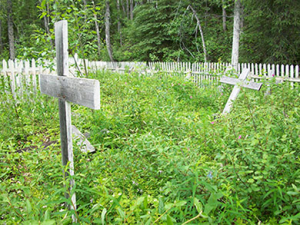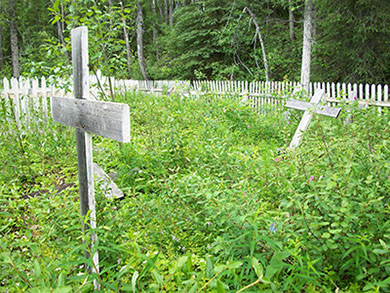
Your ideal goal for self-reliance is to have a plan for every eventuality. And sometimes we have to plan for dealing with the very worst case imaginable.
In the case of the disposal of dead bodies in emergency conditions, the World Health Organization Technical Note for Emergencies No. 8 provides useful guidance. You can find it on the WHO website. (There’s a PDF here.) If it’s possible leave a tag with details on the corpse, and keep a separate record to hand to authorities if you get to report the death yourself.
Physical concerns
The widespread belief that corpses pose a risk of communicable disease is wrong. Especially if death resulted from trauma, as is most typical in emergencies such as a bombing, fire, earthquake, etc., bodies are very unlikely to cause outbreaks of diseases though they may transmit gastroenteritis or food poisoning to survivors if they contaminate streams, wells, or other water sources.
When the body dies, the environment sustaining the infection dies too, and so will the germs, although times vary. However, in cases where diseases are spread by tick or flea (e.g. the very rare typhus or plague) – be very careful. These carriers will be looking for a new host. TB, as a bacterium, can exist without a host. It is good practice when moving a corpse suspected of having TB to put a cloth over their nose and mouth, and a mask over yours, in order to prevent accidental inhalation of infectious bacteria.
If you are in an area where HIV/AIDS or Hepatitis (A, B, or C) are common then there is a chance that these bloodborne pathogens may pass to you from a dead body. Infectious HIV can survive in cadavers for a long time (up to 16 days after death if stored at 35ºF). Take care not to incur a needle-stick injury. Touching the skin is fine; just avoid body fluid-to-fluid contact. But remember, in the US, these diseases exist in extremely low percentages. Many of us have had a HepB shot – if you haven’t – get to it. And take basic precautions such as wearing gloves.
Which all means that you shouldn’t freak out over the health risk of dead bodies. Most populations do not have lots of sick people and most disasters tend to kill healthy people.
Mental health risks
The psychological trauma of losing loved ones and witnessing death on a large scale is a great cause for concern in most disasters. People want to do something. They may believe that outside help will be a long time coming and they will want to be useful. However, it is not necessary to rush burial or cremation. What is important is that you make the correct identification and keep good records of the dead. When the world catches up with you following an emergency, the authorities will appreciate any information you can give them that will help them to work out what actually happened. It will also support your side of the argument if angry relatives start to ask questions regarding your survival and the loss of a family member. If you’re in a Will, make sure any accusations that you used a disaster to speed up your inheritance can be squashed.
In the military they have an expression: “bag ‘em and tag ‘em”. This is crucial if you are dealing with more than one death. It is very important that you do not have a mass grave. If you bury a dead person or persons, keep them separate and make sure their details: name, age, and cause, time, location and date of death (if known) are with them. Write this out and put it in a baggie or a sealed tin and bury with the deceased. Keep a record for yourself and the authorities. If you have not buried your dead but instead made a makeshift morgue, make sure that all the details are with the bodies. Ideally, bodies should be stored at 4ºC, although this is rarely possible.
Burial
Burial is the preferred method of body disposal in emergency situations unless there are cultural and religious reasons that prohibit it. WHO recommendations for a mass burial advise that burials should be at least 160ft away from groundwater drinking sources and preferably 500 yards from the nearest home. Burial depth should be about 6ft above the groundwater table, with at least a three feet covering of soil. If coffins are not available, corpses should be wrapped in plastic sheeting to keep the remains separate from the soil. Although I have never seen any statistics for it, I assume that if you live a few feet above groundwater in a built-up area (like me), your emergency grave should be constructed by making a mound of earth or stones, wrapping the body in several layers of plastic, laying it on the mound and covering with another yard of dirt. I guess that animals pose the greatest threat in this situation so if you can construct a basic wooden coffin you will reduce your chances of having the body disturbed. Remember, if you are in a built-up area, you will probably receive help first.
Cremation
There are no health advantages of cremation over burial but some communities may prefer it for religious or cultural reasons. Factors against it are the amount of fuel required by a single cremation (approx 650lbs wood) and the smoke pollution caused. Cremation sites should be located at least 500 yards downwind of dwellings. Remember to capture photos and DNA records of the deceased for the aftermath.
Handling the body
If you have to touch a body, wear disposable rubber/plastic gloves or regularly disinfected cloth gloves. Tie your hair back. Wear a mask if you feel it’s necessary. You can use large plastic bags – the biggest lawn/trash bags you can find — or heavy plastic sheeting to enclose the body. If you feel the need to cleanse the body, wipe it with a mild bleach solution and be very careful of feces as they do carry infectious agents. You may consider packing orifices with cotton wool or wadding before moving a body. Dispose of your gloves carefully.
Only in a bioterror attack will you encounter these diseases. Mind these precautions:
Cholera
Contact with an infected body leads to exposure to cholera vibriosand requires careful washing using soap and water.
Ebola
Ebola is spread through bodily secretions such as blood, saliva, semen, vomit, urine and stools and the body can remain infectious for several weeks. Dried blood is not thought to be a risk. It can be killed with 2% diluted bleach. Those dealing with the disposal of bodies require very high levels of protection.
Typhus and plague
To avoid infestation with the fleas and lice that spread these diseases, protective clothing should be worn. Body bags should be used to store the bodies prior to burial or cremation. Remember that pets can be hosts to disease-carrying fleas, lice and ticks.
